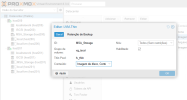Hi, new Korean newbie is here.
It's just a question, could I add physical storage as 1 node in cluster?
I think, as far as I know, it's impossible because clustering requires pve os.
It's a shame, but I've been working as a hardware engineer for less than a year.
I hope anyone tell me truth.
Thx.
It's just a question, could I add physical storage as 1 node in cluster?
I think, as far as I know, it's impossible because clustering requires pve os.
It's a shame, but I've been working as a hardware engineer for less than a year.
I hope anyone tell me truth.
Thx.
Last edited:





